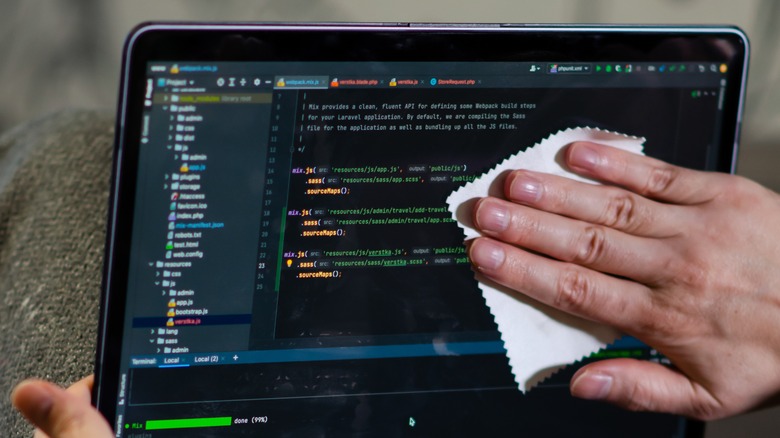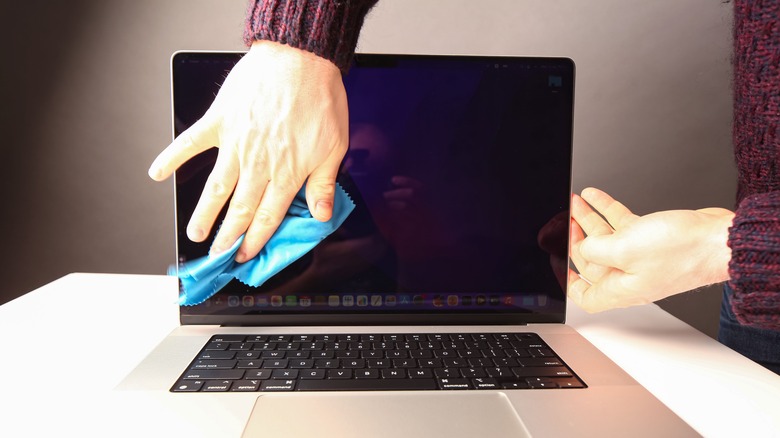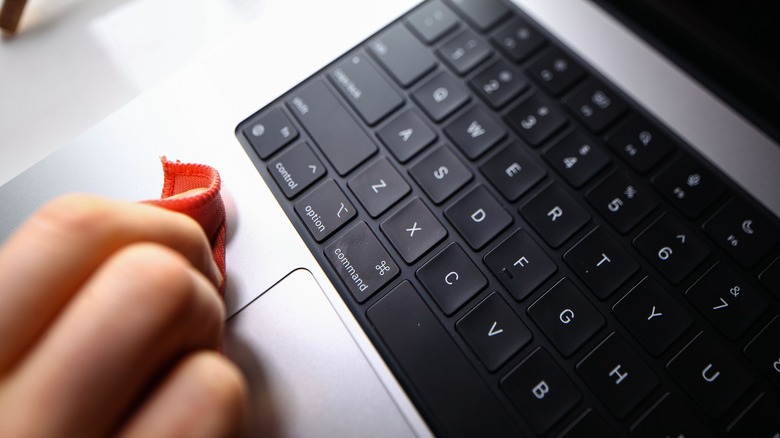How To Clean Your Mac Laptop
A Macbook is a mean machine — it's one of the best laptops around, and Apple continues to improve on it to ensure a superior experience. The icing on the cake is that it looks the part — Mac hardware is sleek and modern, and when you first get it, very shiny. But with use, your Mac's once-shiny surface starts to collect dust and smudges, and the ports start to accumulate grime. Not only does this make your laptop look less impressive than it is, but it's also very unsanitary — the University of Arizona researchers found that the average computer keyboard has 400 times more bacteria than a toilet seat (via Center for Research), and that's not hyperbole.
If you think it sounds far-fetched, consider how many times you use your laptop with unwashed or greasy hands, or spill drinks and litter crumbs on it. If you own pets, chances are that your laptop also gets its share of furry attention (and bacteria). All this activity deposits and transports invisible microbes which, in the long run, can make you more likely to get sick. According to iNews UK, researchers found a common bacterium on keyboards called Staphylococcus aureus, which can cause stomach upsets and a range of other illnesses.
It's completely reasonable if this news makes you want to immediately wipe your laptop down with a sanitizer, but you must be careful about how you clean your Mac — don't forget it's electronic with delicate electrical components. We'll walk you through how to keep your Mac shiny and disinfected without causing it any damage.
How to clean your Mac
The first thing you want to do is turn off your Mac, then unplug the power cord and any other connected device. You can clean the laptop in three sections: the lid and bottom, the screen, and the keyboard.
To start, lightly dampen a clean, soft, lint-free cloth with water — emphasis on the "lint-free." If you use a hard or rough cloth — you might end up with scratches on your screen. You can find good deals on Amazon for packs of lint-free cloth that provide value for money, which is more than we can say for Apple's $20 "polishing" cloth. Make sure to squeeze out excess moisture so the cloth is not dripping — you don't want to get moisture in the openings. Gently wipe down the lid and the bottom, and you can follow that by swiping with a dry, lint-free cloth to prevent streaks.
It's pretty much the same process to clean the screen, but you want to be extra careful because Mac screens are even more delicate than the other parts. You can use a dedicated screen cleaner if you're battling with tough stains and smudges, but Apple warns against using products containing acetone. It also specifies that you don't use "window cleaners, household cleaners, aerosol sprays, solvents, ammonia, abrasives, or cleaners containing hydrogen peroxide". You should also be careful to not spray cleaning products directly onto the screen — the moisture might drip inside the display and damage it, or other parts of your Mac.
How to disinfect your Mac keyboard
Unlike the screen and body of your Mac, water won't cut it as a cleaning agent for your keyboard. It's the part of the computer that gets the most contact with your hands, which means it needs to be thoroughly disinfected. Apple recommends using products with 70 percent isopropyl alcohol or 75 percent ethyl alcohol wipe as disinfectants, and again, products containing bleach or hydrogen peroxide are a no-no.
Once again, use a soft, lint-free cloth and very little liquid — the keyboard sits right on top of the main components of your Mac's chassis, and any excess moisture could make its way down the sides of the keys and cause water damage. Check that the cloth you're using does not have any frays or loose threads, as those could be caught between the keypads and pull out the keys. If you're not sure you'll be super gentle with a cloth, try a Q-tip instead. Dip it inside the disinfectant, then shake off the excess moisture (you can even pat dry with a paper towel to be double safe), then drag the tip between the keyboard rows to clean them out.
After you've given everything a once-over with the disinfectant, wipe the keyboard down with a water-dampened cloth to remove any leftover cleaner that might cause damage. We advise that you keep up this practice at intervals — you could clean your Mac once a week or bi-weekly to keep it looking shiny and more importantly, germ-free.


